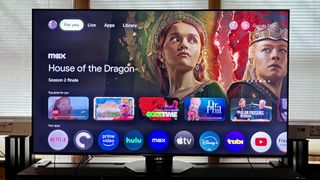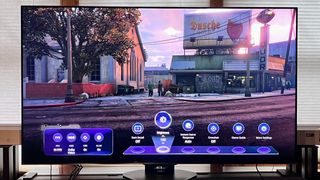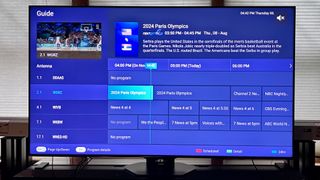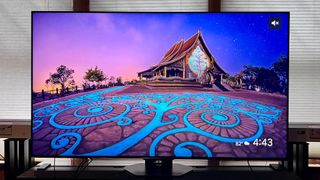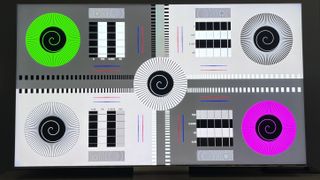Hisense U8N: Two-minute review
Table of Contents
The Hisense U8N is the company’s next-to-top mini-LED TV series for 2024, slotting in between the Hisense U7N and Hisense U9N. This new series follows the same path as the Hisense U8K, one of the best TVs of 2023, by boosting brightness over its predecessor and refining picture processing with a focus on local dimming performance.
While most TVs provide only incremental improvements over last year’s model, the new Hisense U8N takes a dramatic performance leap, specifically in its peak brightness, which is nearly twice what I measured on the Hisense U8K. Local dimming has also been improved, and even the TV’s sound quality seems better. Many of these performance boosts mirror what I found on the new TCL QM851G mini-LED model that rivals it – perhaps not surprising given the determination both brands have shown in recent years to not just break through, but dominate the US TV market.
The Hisense U8N has mostly similar gaming features to the U8K, with two HDMI 2.1 ports that support up to 4K 144Hz, VRR including FreeSync Premium Pro, ALLM, and Dolby Vision gaming, Those features, plus a Game Bar menu for on-the-fly tweaking of picture settings, make it a great TV for gaming, although we really want to see four HDMI 2.1 ports in the best gaming TVs. Google TV is used for the U8N’s smart TV platform in the US, and Hisense’s own VIDAA platform in the UK, Australia, and elsewhere.
Along with video and audio performance, design is an area where Hisense made some tweaks for the new series. The U8N has an adjustable-height pedestal stand as opposed to the U8K’s adjustable-width support feet. And Hisense’s full-size, backlit remote control is also a big improvement on the cheap-feeling compact one included with last year’s U8K. It also has an ATSC 3.0 tuner for receiving next-gen broadcast TV channels in the US.
Hisense TVs continue to be high-value options, and that includes the new U8N. At $1,499.99 / £1,799 / AU$2,699 list for the 65-inch model and with price drops in the US since launch, the U8N provides formidable competition to mini-LED offerings from traditional premium brands like Samsung, Sony, and LG, and is even priced lower than the TCL QM851G while providing mostly similar features and performance, making it an incredibly tempting option.
Hisense U8N review: Price and release date
- Release date: April 2024
- 55U8N: $1,099.99
- 65U8N: $1,499.99 / £1,799 / AU$2,699.99
- 75U8N: $1,799.99 / £2,299 / AU$3,699.99
- 85U8N: $2,799.99 / AU$4,999.99
The Hisense U8N series was released in April 2024 in screen sizes ranging from 55 inches to 85 inches. All sizes are available in the US, while the 65- and 75-inch models are sold in the UK and the 65-, 75-, and 85-inch sizes in Australia.
Prices for all models have dropped in all markets for the U8N series since launch, with the 65-inch model I tested selling for $1,299 in the US at the time of writing. Prices tend to fall fast on Hisense models in the US than in the UK and Australia, so the TV may be better value there than in other countries – I’m based in the US, and I’ll be making my value judgments on the aggressive US pricing.
Hisense U8N review: Specs
| Screen type: | QLED with mini-LED |
| Refresh rate: | 120Hz (up to 144Hz) |
| HDR support: | Dolby Vision IQ, HDR10+, HDR10, HLG |
| Audio support: | Dolby Atmos, DTS:X |
| Smart TV: | Google TV (US), VIDAA elsewhere |
| HDMI ports: | 4 (2x HDMI 2.1) |
| Built-in tuner: | ATSC 3.0 (US) |
Hisense U8N review: Benchmark results
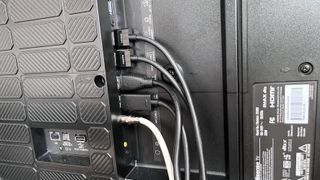
Hisense U8N review: Features
- 2x HDMI 2.1 inputs with 144Hz support
- Built-in ATSC 3.0 tuner
- Low-reflection screen
Hisense U8N series TVs feature a new Hi-View Engine PRO processor that, according to the company, “leverages deep learning” to deliver AI-fueled dynamic HDR tone mapping, face detection, and detail enhancement. The mini-LED backlight in U8N series TVs is specified as having twice as many local dimming zones as last year’s U8K series models. It also has an anti-glare low-reflection screen, a 50W 2.1.2-channel built-in speaker system with Dolby Atmos and DTS:X support, Wi-Fi 6E for streaming, and an ATSC 3.0 tuner in the US to receive next-gen TV broadcasts.
For high dynamic range support, the U8N series handles Dolby Vision (IQ), HDR10+, HDR10, and HLG formats, and there’s a Filmmaker Mode for an accurate, director-approved picture out-of-the-box without having to play with picture settings. The U8N series is also IMAX Enhanced certified.
Gaming features on the U8N series include two HDMI 2.1 ports with support for up to a 144Hz refresh rate, VRR including FreeSync Premium Pro, and 4K Dolby Vision gaming. The Google TV smart TV platform is used for US models and Hisense’s own VIDAA platform in the UK and Australia. AirPlay 2 and Chromecast are onboard for wireless streaming, and Google voice assistant is supported, with the option to use either the remote control’s built-in mic or the TV’s internal mic for hands-free control.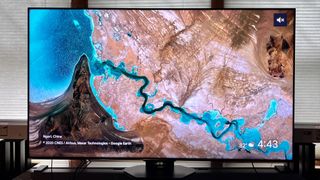
Hisense U8N review: Picture quality
- High brightness
- Powerful local dimming
- Just-average motion handling
I’ve mentioned it a few times already, but this TV is astonishingly bright. Measured in Filmmaker mode at the default picture settings, the 65-inch U8N essentially matched the peak brightness numbers (in Movie mode) of the TCL QM851G, which had earned a designation as the brightest TV TechRadar had yet tested at the time of our review. An HDR white window pattern covering 10% of the screen yielded 2,851 nits, and a full-screen pattern measured 805 nits. The U8N also had outstanding brightness in Standard mode with both HDR and standard dynamic range sources, measuring 2,920 and 2,770 nits, respectively, on a 10% pattern.
The U8N also had strong measured results for color, hitting 96.3% of UHDA-P3 (the color space used for mastering 4K Blu-rays and digital cinema and streaming releases) and 81.9% of BT.2020. Color accuracy in Filmmaker mode was below the margin of error threshold we use for a benchmark (ie, if it were any more accurate, you wouldn’t be able to tell the difference anyway), though grayscale accuracy came in slightly above that point – a situation helped by changing the Gamma preset in the TV’s picture Brightness settings sub-menu to 2.2, bringing it to a high-enough level of accuracy.
What did all of the above equate to when watching TV with the Hisense U8N? Pictures were wonderfully bright and punchy, with impressive detail and depth. Watching a broadcast of the 2024 Summer Olympics in Paris, the powerful effect of overhead lights beaming on the athletes brought the games to life, while colors in the uniforms looked rich and robust. Mind you, this was a regular high-definition broadcast, though it was carried with Dolby Vision HDR in the US on ATSC 3.0 broadcast TV channels.
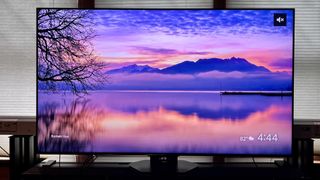
(Image credit: Future)
I generally found the Hisense U8N to be a great TV for viewing sports, with its high brightness complemented by a low-reflection screen that made quick work of any would-be glare induced by my room’s overhead lights. The one weak point was the U8N’s off-axis uniformity – when viewed from a far off-center seat, both color and contrast noticeably faded.
The U8N’s powerful local dimming delivered deep blacks and refined shadows in shows such as House of the Dragon on Max. When I watched the season 2 finale, scenes that take place in dark chambers revealed plenty of detail in the backgrounds and the characters’ clothing. Candles illuminating these spaces popped out briskly against the dark backgrounds, giving pictures a strong sense of dimensionality.
Checking out a few segments from the demo reel section of the Spears & Munsil Ultra HD Benchmark 4K Blu-ray disc that I use to evaluate local dimming, there were virtually no backlight blooming artifacts to be seen in high-contrast images. A starfield test sequence indicated that the TV’s local dimming was a bit too aggressive at its High setting (the default in Filmmaker Mode), however, obscuring bright pinpoints of light that were otherwise visible with the local dimming set to Low or Off.
Motion handling on the U8N is one of its weaker points. When I watched a scene from No Time to Die where James Bond walks across a craggy hillside cemetery, the texture of the landscape and the monuments lining it both lost detail and took on a “smeared” quality as the camera panned horizontally. Setting the Blur and Judder adjustments in the Custom Motion Enhancement sub-menu to a low setting (I settled on 3 for both) fixed this, however, and didn’t introduce any noticeable soap opera effect.
- Picture quality score: 4.5/5
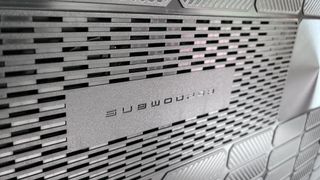
That’s a subwoofer on the U8N’s back panel, in case you need it spelled out for you. (Image credit: Future)
Hisense U8N review: Sound quality
- 2.1.2-channel Dolby Atmos speaker system
- Extensive sound adjustments
- Very good sound quality
The Hisense U8N’s 2.1.2-channel built-in speaker system supports both Dolby Atmos and DTS:X immersive sound formats. A subwoofer on the TV’s back panel (a slightly protruding, vented section that’s actually labeled “subwoofer”) adds a good dose of bass to soundtracks and there are upfiring speakers for height effects.
Hisense provides plenty of settings to tweak audio quality in the TV Sound Effect menu. There are seven sound mode presets, including Theater (the one I mainly used) and Intelligent Sound. An Advanced Settings sub-menu offers Auto Acoustic Tuning, a process that uses the mic built into the remote control to adapt the sound to the space the TV is set up in, along with Equalizer, left-right Balance, and subwoofer level settings.
I was very impressed with the U8N’s sound quality. Dialogue was clear and full, and the built-in subwoofer made bass effects sound surprisingly weighty. The sound level was plenty loud in my space even with the volume at a relatively low setting. When I watched a chase scene through a village in No Time to Die, directional effects such as the trajectory of the cars and motorcycle came across vividly, extending well beyond the screen, and Atmos effects such as the clanging of a church bell had an impressive sense of height as well. Although we usually recommend adding one of the best Dolby Atmos soundbars to a TV, I think plenty of people will be happy with the U8N’s built-in speakers.
- Sound quality score: 4.5/5
The U8N’s adjustable-height aluminum pedestal stand. (Image credit: Future)



